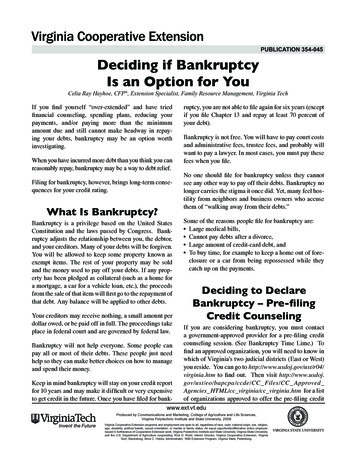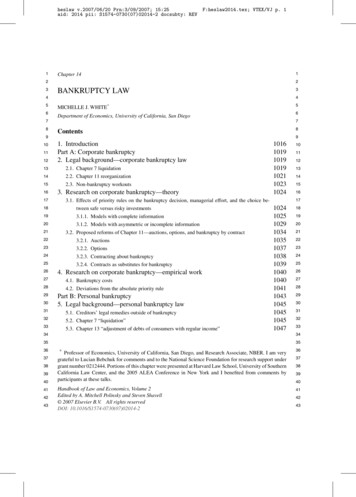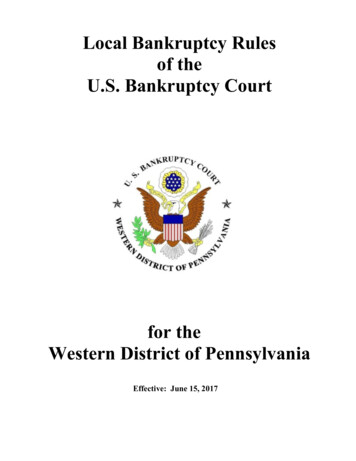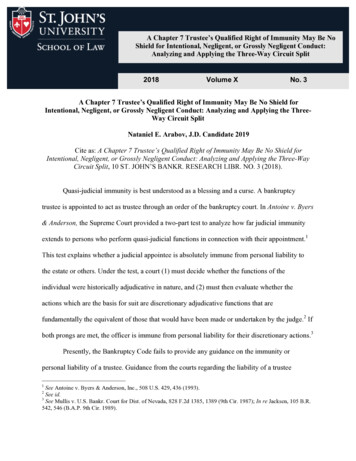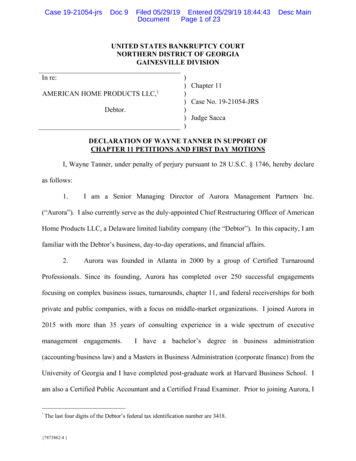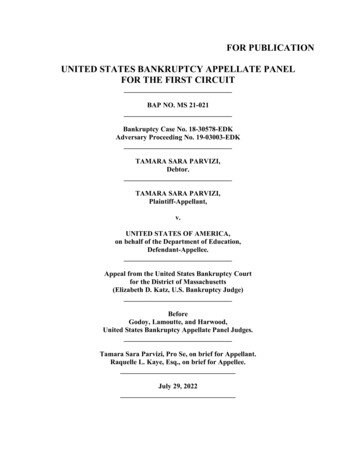
Transcription
FOR PUBLICATIONUNITED STATES BANKRUPTCY APPELLATE PANELFOR THE FIRST CIRCUITBAP NO. MS 21-021Bankruptcy Case No. 18-30578-EDKAdversary Proceeding No. 19-03003-EDKTAMARA SARA PARVIZI,Debtor.TAMARA SARA PARVIZI,Plaintiff-Appellant,v.UNITED STATES OF AMERICA,on behalf of the Department of Education,Defendant-Appellee.Appeal from the United States Bankruptcy Courtfor the District of Massachusetts(Elizabeth D. Katz, U.S. Bankruptcy Judge)BeforeGodoy, Lamoutte, and Harwood,United States Bankruptcy Appellate Panel Judges.Tamara Sara Parvizi, Pro Se, on brief for Appellant.Raquelle L. Kaye, Esq., on brief for Appellee.July 29, 2022
Lamoutte, U.S. Bankruptcy Appellate Panel Judge.After a trial, the bankruptcy court determined that the more than 650,000 in student loandebt Tamara S. Parvizi (the “Debtor”) owed to the United States Department of Education (the“DOE”) was excepted from discharge under § 523(a)(8).1 The Debtor appealed. Finding noerror of law or fact by the bankruptcy court, we AFFIRM.BACKGROUNDI.The Debtor’s Bankruptcy FilingThe Debtor filed a chapter 7 bankruptcy petition in July 2018. On her bankruptcyschedules, she listed minimal assets totaling about 9,800, consisting primarily of a car and someelectronics. She identified a single secured creditor with an 8,664 claim secured by a lien onher car and more than 630,000 in unsecured claims, which was mostly student loan debt. TheDebtor indicated she earned 1,600 per month working as an adjunct professor at a communitycollege and her monthly expenses totaled 1,740.The Debtor received a chapter 7 discharge on January 28, 2019.II.Adversary ProceedingTwo days after receiving her discharge, the Debtor commenced an adversary proceedingagainst the DOE seeking to discharge her student loan debt. In her complaint,2 the Debtoralleged she had incurred 500,000 in student loans to attend St. George’s University School ofMedicine. After earning her medical degree, she began a residency program in psychiatry at theUniversity of Vermont Medical Center (“UVM Medical Center”). She did not complete the1All references to specific statutory sections are to the United States Bankruptcy Code, 11 U.S.C.§§ 101-1532.2The Debtor’s “complaint” was in the form of a two-page letter to the bankruptcy court. She did not cite§ 523 or specifically request to discharge her debt. However, the court (and the DOE) treated the “letter”as a complaint seeking to discharge the Debtor’s student loan debt under § 523, and we do the same.2
program, however, due to a dispute with the program’s director. She claimed the director wasintent on “dispos[ing] of her” by “ruining [her] reputation.” She also complained that,unbeknownst to her, the director had an “unpleasant history with regard to treatment of certainresidents” and had failed to disclose a successful lawsuit against the program by a formerresident.The Debtor further alleged that after leaving the residency program in 2013, she “appliedto hundreds of residency programs . . . and met with failure each time.” She emphasized shewas, at that time, 50 years old, had “zero savings,” and the only job she could find was teachingbiology courses as an adjunct faculty member at various local colleges, which was not a stablesource of income. The Debtor stated that her income for the prior month (December 2018) wasonly 1,072 and she was one month behind on her rent payment and two months behind on hercar payments. She was unable to “put . . . money away for a rainy day,” she explained, and was“simply trying to survive.” She expressed that “[i]t would be nice to be able to get a little moneyback from [her] federal taxes at the end of the year . . . rather than . . . having it all go towards astudent [loan] debt that [she] c[ouldn’t] even imagine being able to pay off . . . .”III.Stipulated FactsThe matter was scheduled for a trial on September 29, 2020. About a week before trial,the parties filed a joint pretrial memorandum setting forth their stipulated facts, as describedbelow.A.The Debtor’s Student LoansThe Debtor was 50 years old and resided in Providence, Rhode Island. She had nophysical or mental health issues or disabilities that limited her ability to work, and she hadno dependents. Between 2007 and 2013, the Debtor received various student loans to fund3
her education. As a result of that education, the Debtor has obtained multiple degrees, includinga master’s degree and a medical degree. She is also fluent in four languages.The Debtor owes two types of loans to the DOE: (1) federal government funded loansthrough the William D. Ford Federal Direct Loan Program (the “Direct Loans”); and(2) privately funded student loans that were guaranteed and held by the federal governmentthrough the Federal Family Education Loan Program (the “FFELP Loans”) (collectively, the“student loans”). As of September 10, 2020, the Debtor owed the DOE more than 650,000 onher student loans. The Debtor has made no payments toward her student loans except for 3,960.95 in income tax refunds which were credited to her student loan account through theTreasury Offset Program.The Direct Loans are eligible for participation in the Revised Pay As You Earn(“REPAYE”) income-based repayment program, and the FFELP Loans would be eligible uponconsolidation with the Direct Loans. 3 Based on an estimated Adjusted Gross Income of 28,668,the Debtor would pay 80 per month for 25 years under the REPAYE program and the balanceremaining at the end of the 25-year term would be forgiven and canceled. There is no evidencein the record as to what the Debtor’s monthly loan payments would be without the assistance ofan income-based repayment plan.3Under the REPAYE program, a borrower’s aggregate monthly loan payment is limited to 10% of theamount by which the borrower’s adjusted gross income exceeds 150% of the federal poverty guidelineapplicable to the borrower’s family size, divided by 12. If the borrower participates in REPAYE for 25years (for graduate loans), the entire loan balance, including accrued interest, is forgiven and the DOEcancels the debt. If a borrower earns less than 150% of the poverty level for the borrower’s family size,the monthly payment is 0. Years during which a borrower’s monthly payment is 0 count equallytowards the repayment period. Because the monthly REPAYE payment is calculated as a percentage ofa borrower’s income, if a borrower’s income drops, the monthly payment is reduced accordingly. Themonthly payment amount is recalculated annually.4
The Debtor was previously enrolled in an income-based repayment plan with a monthlypayment of 0, effective September 21, 2014. However, her enrollment ended after 12 monthsbecause she failed to recertify her income. Although she remained eligible, she did not re-enrollin any further income-based repayment programs and is “unwilling” to do so.B.The Debtor’s Education and Employment HistoryIn 1990, the Debtor obtained a bachelor’s degree from Clark University. Thereafter, sheattended the University of Rochester School of Medicine from 1991 to 1995 but voluntarily leftbefore receiving a degree. In 1997, the Debtor enrolled in a graduate program at the Universityof Massachusetts Amherst and received a master’s degree in public health in 1999.Thereafter, she worked as an assistant program director for a community healthorganization in Worcester, Massachusetts, earning an annual salary of 30,000- 40,000. She leftthat position after six months to become the director of a public health program affiliated withUMass Memorial Medical Center, where she earned approximately 50,000 per year. TheDebtor left that position after six months because “she was not committed to the organization’smission.”For the next seven years, until attending medical school for the second time in 2008, theDebtor cared for her father, pursued her artistic interests, performed odd jobs, and worked as asubstitute teacher. During this period, in 2007, the Debtor received a 100,000 inheritance. Atthat time, her student loans were in default and she owed approximately 123,000. The Debtoroffered the DOE 45,000 to “compromise” that debt, but the offer was rejected. She did not useany of her inheritance to pay her student loans and has since spent the entire 100,000. 44At a deposition conducted on December 19, 2019, the Debtor explained that when she received theinheritance, she was not working much and so she “lived off of th[at] money.”5
In 2008, the Debtor returned to medical school at St. George’s University School ofMedicine, incurring an additional 500,000 in student loans. She graduated with a Doctor ofMedicine degree in 2012 and then began a residency program in psychiatry at UVM MedicalCenter, earning 50,000 per year. She did not complete the program, however, due to a “conflictwith the program director.” As a result of the “conflict,” the Debtor was placed “on leave” andshe ultimately resigned from the program. Her voluntary resignation from the residency programwas noted in an April 2013 letter of reference from UVM Medical Center, which acknowledgedthe Debtor had successfully completed her clinical rotations.The residency program continued to pay the Debtor her annual salary until June 2013.The Debtor then spent the next five years applying for residency programs in psychiatry, familymedicine, and pathology. She was not offered a position in another residency program, and shenever became licensed to practice medicine.C.The Debtor’s Income and ExpensesSince departing her residency program, the Debtor has worked primarily as an adjunctprofessor, tutor, and substitute teacher. She earned 28,668 in 2019, 41,336 in 2018, 20,876in 2017, and 21,588 in 2016. At the time of trial, she worked as an adjunct professor at theMassachusetts College of Pharmacy and Health Sciences, earning about 3,400 per month. Hermonthly expenses totaled 1,598, including: 800 for rent; 85 for a storage unit; 108 for carinsurance; 45 for renter’s insurance; 60 for cell phone charges; 300 for groceries; and 200for “discretionary expenses.” Over the course of 2020, the Debtor’s surplus income afterpayment of her expenses ranged from 400 to 1,800 per month.6
IV.TrialThe bankruptcy court conducted a trial on September 29, 2020. The court heardtestimony from the Debtor, and numerous exhibits were admitted into evidence.A.The Debtor’s Direct TestimonyThe Debtor devoted much of her testimony to describing her problems with the residencyprogram at UVM Medical Center. She explained that although the program’s director“recruited” her “quite aggressively,” the director gave her negative feedback from the outset andshe was eventually put on a “modification plan,” which identified certain “performance deficits.”Although she attempted to rebut the accusations against her, she was eventually placed on aleave of absence pending a hearing before the residency committee. When she began looking foran attorney to represent her, she discovered that the year before she entered the residencyprogram, another psychiatric resident at UVM Medical Center had prevailed in a major lawsuitagainst the program for breach of her employment contract.The Debtor explained that because the hearing before the residency committee did notoccur within four weeks, she missed the window to try to transfer to another program through theresidency “scramble” which occurs every spring at the conclusion of the annual “match” process.She ultimately resigned from the program and then spent the next five years applying toresidency programs in psychiatry, family medicine, and pathology without success. She was atthat time teaching as an adjunct professor and substitute teacher, without any benefits or jobsecurity.B.Cross-Examination by the DOEOn cross-examination, the Debtor confirmed her monthly expenses were approximately 1,600, which included 200 for “discretionary spending.” She agreed her income was7
“variable,” but she did have periods of time where she had extra income after paying hermonthly expenses. She did not save any of that money and could not recall how she spent it.When asked whether, during a two-month period in mid-2019, she spent over 1,500 at clothingstores, at household gift shops, and on Etsy.com and more than 900 on meals out, coffee, andAmazon and PayPal purchases, she agreed it was “possibl[e].”The Debtor confirmed she was unwilling to participate in an income-based repaymentprogram and insisted she could not afford to pay 80 per month toward her student loans undersuch a program. When questioned if she spends more than 80 per month on discretionarypurchases, the Debtor responded: “I can’t answer that question.”When she was asked whether she has sought work in the medical field after leavingUVM Medical Center (other than applying for residency programs), the Debtor responded that in2013-2014, she sought work as a program manager for various research programs withoutsuccess so she “gave up after a while.” When asked whether she “felt that jobs like being aphlebotomist or a medical assistant were not as dignified a way to use [her] knowledge,” theDebtor responded: “I’m qualified to teach. I have a good basis of scientific knowledge, biologyin particular, and that’s what I’ve been doing and I enjoy doing it.” She further stated: “I feellike I’ve suffered enough of a loss that I deserve a sense of dignity in terms of knowing that I’mdoing something . . . that I consider worthwhile.” When asked if she agreed she had “not soughtto maximize [her] income,” she responded that she “didn’t go into medicine to make money,”and her current goal was to find a stable teaching job so she could “live more or lesscomfortably.”8
The Debtor further testified she did not believe she should have to pay back any of herstudent loans and admitted she had not made a single voluntary payment on her student loandebt:Q: . . . Ms. Parvizi, you do not believe you should be required to repay your studentloans, correct?A. Yes, because . . . I believe, in fact, there is a law on the books for excusing paymentof student loans based on whether you’ve been bamboozled out of your education, out of. . . some kind of training and I hope that I’ve proven my case that I have been cheated inno uncertain terms—.Q: Thank you. And . . . just to be clear, you have never once made a single voluntarypayment towards your student loan debt, is that correct?A: That is correct, yes.C.The Debtor’s Testimony on Redirect ExaminationDuring her redirect examination, the Debtor insisted she had “knocked on every door” inan effort to “recover” her profession and she “had every intention of” paying her student loans.The bankruptcy court queried why, then, was she unwilling to participate in an income-basedrepayment program:Q: . . . [L]et me ask you this question, Ms. Parvizi, because . . . you briefly for 12months entered the income-based repayment program and then failed to fill out . . .a form . . . . and during that whole 12 months your payment was zero dollars. Sowhy are . . . you[] unwilling . . . to enter that income-based repayment program?Please answer that question.A: Yeah. Because I guess after a conversation with someone at that time and aftersome thinking on my own, I realized why should I pay for the mistakes of aresidency program director whose behavior has cost me my life, my pursuit ofhappiness. . . . Why should I pay for that person’s mistake? I mean, the hospitalpaid for her mistakes once months before I entered that program and here I am. . . .Q: But why is it the fault of the Department of Educa[tion]—A: Why should I pay for her mistake?Q: Ms. Parvizi, but why is that the fault of the Department of Education?9
A: Well, isn’t there . . . a law . . . where the Department of Education forgives loansthat have been taken out by people . . . at [un]accredited institutions . . . [that] tookstudent money and basically left them with something . . . really worthless.I think I’m trying to make a similar argument . . . . [T]he way that I was dismissedfrom my training was completely outrageous . . . . [W]hy should I be beholden to payback . . . money that was supposed to be put towards my training [but] was not . . . .D.The DOE’s Closing ArgumentDuring her closing argument, the DOE’s counsel emphasized that the Debtor had morethan 650,000 in outstanding student loan debt, had never made a single voluntary paymenttoward her student loans, and her “refusal to make payments towards her student loans beganlong before her issues with her residency program.” She further argued that while the Debtor’sexperience with her residency program was not ideal, her focus on those circumstances was“misplaced.” The court was required to look at the totality of the circumstances, which reflectedthe Debtor had a “history of substantial discretionary spending” and she consistently had enoughsurplus income to pay 80 per month toward her student loans under an income-based repaymentprogram. She argued:DOE is only asking her to contribute a small fraction of that discretionary incometo her taxpayer funded debt. If [the Debtor] is unable to maintain the same levelof income next year her payments will decrease accordingly and could be as lowas zero dollars per month and still count towards her repayment obligation.At the end of the program the debt will be discharged, regardless of whetherthere’s any outstanding balance due. One cannot reasonably conclude that asking[the Debtor] to enroll in an income-based repayment program and repay someportion of her student loans would create an undue hardship.E.The Debtor’s Closing ArgumentIn her closing argument, the Debtor re-emphasized that her problems with the programdirector at UVM Medical Center “ruined [her] career.” “[I]f none of this . . . is enough toconvince you that I’ve had my life ruined [and] that it’s okay for someone who has had their life10
ruined to spend an extra 1500 at some point [rather than] put that money towards paying studentloans . . . that were taken out for training that never happened, [then] maybe the FBI shouldinvestigate,” she argued.V.The Court’s Ruling and Subsequent EventsA.First Amended Judgment and Amended Memorandum of DecisionOn May 13, 2021, the bankruptcy court entered an Amended Judgment (the “FirstAmended Judgment”) and Amended Memorandum of Decision ruling that the Debtor’s studentloan debt was excepted from discharge under § 523(a)(8).5 Applying the totality of thecircumstances test—which the parties had stipulated was the appropriate test and which courts inMassachusetts have previously adopted—the bankruptcy court concluded the Debtor did notprove by a preponderance of the evidence that excepting her student loan debt from dischargewould impose an undue hardship. The court reasoned:Here, the Debtor is highly educated, has no dependents, suffers from no physicalor mental conditions that impede her ability to work, and, at age fifty-one, likelyhas many more years of being able to productively work before retirement.While the Debtor attempted to place the blame for her inability to make paymentson her student loans upon her uncompleted residency program and at severalpoints stated that she had “knocked on every door,” she has also acknowledgedthat a substantial barrier toward repayment has been her own lack of motivation toincrease her earnings—“[r]ealistically, there is no way I can make a dent in thisgiven my lack of ambition for making money.” Dep. Tr. 82:11-26. Simply put,while the trajectory of her medical residency experience was not ideal, the Debtorhas not shown any effort to maximize her income based on her education andmarketable skills. The Debtor may not have the willingness, but she certainly hasthe capability, to find a higher-paying job that would better exploit her educationand experience or to supplement her income with additional part-time work. SeeJoyce [v. Mt. Peaks Fin. Servs. (In re Joyce), BAP No. MW 05-010, 2005 WL3946869 (B.A.P. 1st Cir. July 29, 2005)] (debtor who argued his medical degreewas not marketable because debtor had not completed residency and had left themedical field several years ago did not prove that he had “exhausted all5The bankruptcy court entered its initial Judgment and Memorandum of Decision on May 12, 2021, butentered amended versions the next day.11
opportunities available to someone with his educational background andprofessional experience”).However, common sense leads the Court to conclude that, with over 650,000 inoutstanding student loan debt, the monthly payment amount outside of an incomebased repayment program would likely be insurmountable even were the Debtorto maximize her income. But the Debtor’s ability to participate in the REPAYEprogram weighs heavily against the Debtor’s argument that repayment of thestudent loans would impose an undue hardship. The evidence presented at trial,and stipulated to by the Debtor, demonstrates that the Debtor has consistently hadmonthly discretionary income sufficient to make the estimated 80 per monthpayment towards her student loans under the REPAYE program. In fact, basedon the evidence presented, the Court finds that the Debtor has consistently hadmore than sufficient discretionary income to allow the Debtor to comfortablyparticipate in an income-based repayment program, despite any protestations tothe contrary.In sum, based on the totality of the circumstances, the Debtor has not proven by apreponderance of the evidence that excepting her student loans from dischargewould impose an undue hardship pursuant to § 523(a)(8).Parvizi v. U.S. Dep’t of Educ. (In re Parvizi), Adv. Pro No. 19-3003, 2021 WL 1921121, at *6-7(Bankr. D. Mass. May 13, 2021) (emphasis added) (footnote omitted). However, the courtfurther ruled:[T]he Court does find that to the extent the Debtor is unable to repay the studentloans in full by the end of any applicable income-contingent repayment program,the negative amortization of the debt and accrued interest would undoubtedlyconstitute an undue hardship to the Debtor at that time. . . .Accordingly, judgment will enter for the DOE, except that pursuant to § 105(a),the Court will order that any student loan debt remaining unpaid upon theDebtor’s completion of the REPAYE program or any comparable program isdeemed discharged as an undue hardship pursuant to § 523(a)(8).Id. at *7. Consistent with the Amended Memorandum of Decision, the First Amended Judgmentprovided:For the reasons set forth in the Court’s Memorandum of Decision dated May 13,2021, judgment is hereby entered in favor of the defendant, United StatesDepartment of Education (the “DOE”), and against the plaintiff, Tamara SaraParvizi (the “Debtor”), except that pursuant to 11 U.S.C. § 105(a), any of theDebtor’s student loan debt currently held by the DOE that remains outstanding12
upon the Debtor’s completion of payments under the REPAYE program orany similar income-based repayment program is deemed discharged pursuant to11 U.S.C. § 523(a)(8). In the event the Debtor is not eligible for REPAYE or asimilar program, this judgment is without prejudice to the Debtor’s right to file arenewed request for discharge of the student loans and a review of the Debtor’ssituation.B.Motion to Alter or AmendThe DOE filed a Motion to Alter or Amend Judgment (the “Motion to Amend”), askingthe court to remove language in the First Amended Judgment providing that any outstanding debtupon the Debtor’s completion of an income-based repayment program would be deemeddischarged under § 523(a)(8). The DOE argued that whether the Debtor may experience unduehardship at an undetermined point in the future was not ripe for determination. The Debtor didnot oppose the Motion to Amend.C.Notice of AppealWhile the Motion to Amend was still pending, on June 8, 2021, the Debtor filed hernotice of appeal.6D.Order Granting Motion to Amend and Second Amended JudgmentOn July 28, 2021, the bankruptcy court entered an order granting the DOE’s Motion toAmend (the “Order Granting Motion to Amend”), ruling in relevant part:The Motion to Amend the Judgment is hereby GRANTED inasmuch as the Court’sruling that any student loan debt held by the DOE after the completion of paymentsunder an income-based repayment plan would be discharged was beyond the scopeof the arguments raised and evidence presented by the Debtor. . . . Accordingly,the Court will enter an amended judgment in favor of the DOE which removes theprovision that any remaining student loan debt owed to the DOE after thecompletion of the REPAYE or similar program is deemed excepted from the6Although the Debtor identified the order on appeal as the “5/12/2021” judgment, she attached to hernotice of appeal the First Amended Judgment, which replaced the May 12, 2021 judgment. We conclude,therefore, that the Debtor intended to appeal the First Amended Judgment. See Batiz Chamorro v. PuertoRican Cars, Inc., 304 F.3d 1, 3 (1st Cir. 2002) (instructing appellate courts to “construe notices of appealliberally and examine them in the context of the record as a whole”) (citation omitted).13
Debtor’s discharge pursuant to 11 U.S.C. § 523(a)(8). A separate form of judgmentwill enter forthwith.The bankruptcy court then entered the Second Amended Judgment, which eliminated thelanguage challenged by the DOE, providing:For the reasons set forth in the Court’s May 13, 2021 Amended Memorandum ofDecision and the Court’s July 28, 2021 Order granting the Motion to Alter orAmend Judgment filed by the United States Department of Education, judgmentis hereby entered in favor of the defendant, United States Department ofEducation, and against the plaintiff, Tamara Sara Parvizi (the “Debtor”). TheDebtor’s student loans currently held by the United States Department ofEducation are not discharged pursuant to 11 U.S.C. § 523(a)(8), except that in theevent the Debtor is not eligible for REPAYE or a similar program, this judgmentis without prejudice to the Debtor’s right to file a renewed request for discharge ofthe student loans and a review of the Debtor’s situation.E.No Amended Notice of AppealThe Debtor did not amend her notice of appeal to include the Order Granting Motion toAmend, and she does not challenge—in either her statement of the issues on appeal or in herappellate brief—the bankruptcy court’s alteration to the First Amended Judgment as part of thisappeal.POSITIONS OF THE PARTIESI.The DebtorOn appeal, the Debtor argues that the bankruptcy court erred in determining therepayment of more than 650,000 in student loan debt would not cause her “undue hardship.”She emphasizes that, although she is a single woman, with only “one car to [her] name,” nosavings, no home, no job security, and an annual salary of only 20,876- 41,336, the courterroneously concluded she has “‘sufficient discretionary income’ to spare monthly paymentstoward student loans amounting to over 650,000” while maintaining a “reasonable, minimalstandard of living.” (emphasis omitted).14
The Debtor claims the bankruptcy court “belittled” her job search efforts, ignoring thatshe had applied to hundreds of residency programs without receiving a single interview andfailing to recognize that opportunities in the medical field are “scarce and extremelycompetitive,” particularly for physicians who are not board-certified. She also argues thebankruptcy court misinterpreted her statements regarding her “coping attitude”—whereby she“lowered her ambitions” in response to “such abject rejection” in her job search—anderroneously found her inability to pay her student loans was due to “her own lack of motivationto increase her earnings.”Finally, the Debtor contends the bankruptcy court “[m]isrepresented” and disregarded thecircumstances surrounding her resignation from the residency program at UVM Medical Center.She spends a significant portion of her brief arguing that, because she was duped into accepting aposition in the residency program at UVM Medical Center based on the director’smisrepresentations and failure to disclose a successful lawsuit against the program based on“resident abuse,” she should not have to repay her student loans.The Debtor offers no case law or other legal authority to support any of her arguments,other than references to 34 C.F.R. § 685.206 which, she claims for the first time on appeal,provides borrowers with a “defense to repayment” of student loans based on “misrepresentationby an institution.”II.The DOEThe DOE counters there was no error by the bankruptcy court as the Debtor had notestablished, under the totality of the circumstances, that repayment of her student loans wouldcause her undue hardship. The Debtor’s past, present, and future financial resources indicate shecan make monthly payments toward her student loans while maintaining a minimal standard of15
living, the DOE claims. A review of her employment history and her reasonable and necessaryliving expenses reveals she has sufficient surplus income to make payments through an incomebased repayment plan. Further, citing Smith v. U.S. Department of Education (In re Smith),499 B.R. 55, 63-64 (Bankr. D. Mass. 2013) (denying discharge where the court was unable to“say with certainty that the Debtor ha[d] exhausted her earning potential”), the DOE argues thatalthough the Debtor has maintained employment, she has not attempted to maximize her incomein order to pay her loans.Finally, the DOE argues that to the extent the Debtor “attributes her current financialsituation to her inability to complete a residency program, it was ultimately her choice to seekadditional education and, in doing so, to assume additional student loan debt.” According to theDOE, the bankruptcy court correctly observed that “[t]he focus of the Court in determiningwhether a debtor has established undue hardship under § 523(a)(8) is not on whether the debtor’sstudent loan funded education yields any particular result the debtor antici
years (for graduate loans), the entire loan balance, including accrued interest, is forgiven and the DOE cancels the debt. If a borrower earns less than 150% of the poverty level for the borrower's family size, the monthly payment is 0. Years during which a borrower's monthly payment is 0 count equally towards the repayment period.


